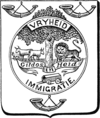
Back Zuid-Afrikaansche Republiek Afrikaans جمهورية إفريقيا الجنوبية Arabic República Sudafricana AST Cənubi Afrika Respublikası (Transvaal) Azerbaijani ترانسوال جومهوریتی AZB Южноафриканска република (Трансваал) Bulgarian República del Transvaal Catalan Transvaalská republika Czech Sydafrikanske republik Danish Südafrikanische Republik German
South African Republic Zuid-Afrikaansche Republiek | |||||||||||||||||||
|---|---|---|---|---|---|---|---|---|---|---|---|---|---|---|---|---|---|---|---|
| 1852–1902 | |||||||||||||||||||
| Motto: "Eendragt maakt magt" Unity makes strength | |||||||||||||||||||
| Anthem: "Volkslied van Transvaal" | |||||||||||||||||||
| National seal | |||||||||||||||||||
 | |||||||||||||||||||
| Capital | Pretoria | ||||||||||||||||||
| |||||||||||||||||||
| Official language | Dutch | ||||||||||||||||||
• Common languages | English, Afrikaans, Pedi, and other Bantu languages | ||||||||||||||||||
| Religion | Dutch Reformed Church[a] | ||||||||||||||||||
| Government | Parliamentary republic | ||||||||||||||||||
| Executive Council | |||||||||||||||||||
• 1857–1860 | Marthinus W. Pretorius | ||||||||||||||||||
• 1860–1862 | Stephanus Schoeman | ||||||||||||||||||
• 1862–1864 | W. C. J. van Rensburg | ||||||||||||||||||
• 1864–1866 | Marthinus Pretorius | ||||||||||||||||||
| State President | |||||||||||||||||||
• 1866–1871 | Marthinus W. Pretorius | ||||||||||||||||||
• 1872–1877 | Thomas F. Burgers | ||||||||||||||||||
• 1883–1902 | Paul Kruger | ||||||||||||||||||
• 1900–1902 (acting) | Schalk Willem Burger | ||||||||||||||||||
| State Secretary | |||||||||||||||||||
• 1880–1888 | Willem Eduard Bok | ||||||||||||||||||
• 1888–1898 | Willem Johannes Leyds | ||||||||||||||||||
• 1898–1902 | Francis William Reitz | ||||||||||||||||||
| Legislature | Volksraad | ||||||||||||||||||
| Establishment | |||||||||||||||||||
| 17 January 1852 | |||||||||||||||||||
| 7 October 1862 | |||||||||||||||||||
| 12 April 1877 | |||||||||||||||||||
| 12 December 1880 | |||||||||||||||||||
| 3 August 1881 | |||||||||||||||||||
| 27 February 1884 | |||||||||||||||||||
| 11 October 1899 | |||||||||||||||||||
| 31 May 1902 | |||||||||||||||||||
| Sep. 1914 – Feb. 1915 | |||||||||||||||||||
| Area | |||||||||||||||||||
• Total | 191,789 km2 (74,050 sq mi) | ||||||||||||||||||
| Population | |||||||||||||||||||
• 1897 | 867,941 | ||||||||||||||||||
| Currency | South African pound | ||||||||||||||||||
| |||||||||||||||||||
| Today part of | |||||||||||||||||||
The South African Republic (Dutch: Zuid-Afrikaansche Republiek, abbreviated ZAR; Afrikaans: Suid-Afrikaanse Republiek), also known as the Transvaal Republic, was an independent Boer republic in Southern Africa which existed from 1852 to 1902, when it was annexed into the British Empire as a result of the Second Boer War.
The ZAR was established as a result of the 1852 Sand River Convention, in which the British government agreed to formally recognise independence of the Boers living north of the Vaal River. Relations between the ZAR and Britain started to deteriorate after the British Cape Colony expanded into the Southern African interior, eventually leading to the outbreak of the First Boer War between the two nations. The Boer victory confirmed the ZAR's independence; however, Anglo-ZAR tensions soon flared up again over various diplomatic issues. In 1899, war again broke out between Britain and the ZAR, which was swiftly occupied by the British military. Many Boer combatants in the ZAR refused to surrender, leading British commander Lord Kitchener to order the adoption of several scorched-earth policies. In the treaty which ended the war, the ZAR was transformed into the Transvaal Colony, and eventually the Union of South Africa. During World War I, there was a failed attempt at resurrecting the republic in the Maritz rebellion.
The land area that was once the ZAR now comprises all or most of the provinces of Gauteng, Limpopo, Mpumalanga, and North West in the northeastern portion of the modern-day Republic of South Africa.
Cite error: There are <ref group=lower-alpha> tags or {{efn}} templates on this page, but the references will not show without a {{reflist|group=lower-alpha}} template or {{notelist}} template (see the help page).
© MMXXIII Rich X Search. We shall prevail. All rights reserved. Rich X Search


